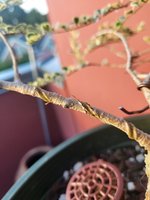pandacular
Omono
While unwiring one of my trees, I found some spots with wire bite that down to fresh, green wood. Is it worthwhile to treat these with cut paste (i. e., Kiyonal or Callus Mate, the proper paste kind not the putty)? Is this part of your practice?
This tree is an Azara, a species of broadleaf evergreen. I understand that wire bite is generally treated differently on deciduous species, so interested to hear about that as well.
This tree is an Azara, a species of broadleaf evergreen. I understand that wire bite is generally treated differently on deciduous species, so interested to hear about that as well.

